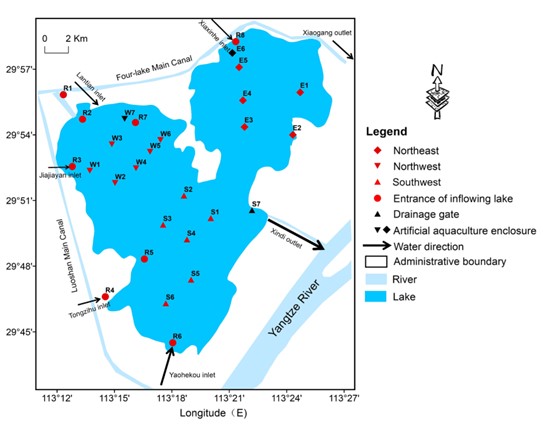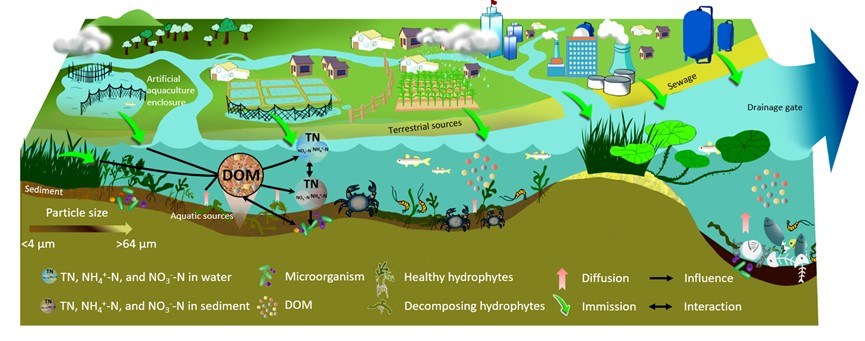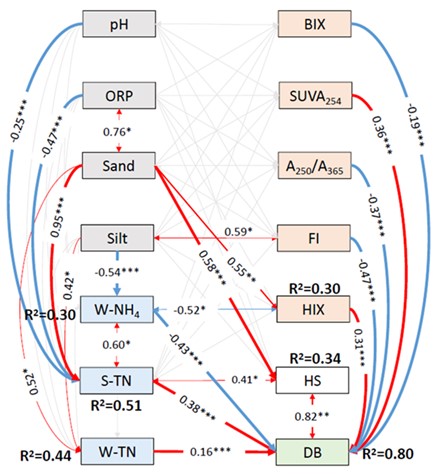Highlights
Researchers Reveal Relationship Between Spatial Distribution Characteristics of Nitrogen and DOM in Large Shallow Degenerating Lake
Abnormal climate, urban expansion, and strong interference of human activities make the nitrogen-containing nutrients in many productive or functional lakes maintain a high level for a long time. As a key nutrient element affecting lake eutrophication, the transport and transformation of nitrogen in the water column is closely related to the structure and composition of dissolved organic matter (DOM).
DOM in aquatic environment includes exogenous DOM from human activities such as domestic sewage, industrial wastewater and agricultural runoff, while a great deal of decaying aquatic plants in degenerating lakes contribute a large amount of endogenous DOM, resulting in complexity and heterogeneity of DOM distribution. Moreover, DOM can be used as a carbon source and nutrients affecting microbial activity. Different DOM sources and proportions determine their bioavailability. However, the interactions among nitrogen, DOM and microorganisms in degenerating lakes are not clear, and the coupling mechanisms among them are rarely studied.
Recently, a research team led by Prof. WU Zhenbin from the Institute of Hydrobiology (IHB) of the Chinese Academy of Sciences revealed the internal causes of nitrogen accumulation at the sediment micro-interface of Honghu Lake, a typical large shallow lake in the middle and lower reaches of the Yangtze River. The study was published in Journal of Cleaner Production.
In this study, the researchers found that, the distribution of different forms of inorganic nitrogen in Honghu Lake showed spatial heterogeneity with the direction of the flow field. The physical and chemical analysis of the sediments showed that the characteristics of sediments with strong polarity and high nutrient adsorption capacity (high proportion of silt component) resulted in the high content of total nitrogen and ammonia nitrogen in the southwest region.
In addition, the large-scale decline of aquatic plants increased the accumulation of nitrogen in sediments in southwest region. Microbial high-throughput sequencing results suggested that the low abundance of bacteria associated with nitrogen cycle in sediments affected the bioavailability and transformation of nitrogen, and ultimately led to the nitrogen content increase in sediments.
Due to the combined influence of exogenous and endogenous DOM pollution, the distribution and transformation of DOM humus components showed a large spatial difference. Through structural equation model analysis, the researchers confirmed that the coupling of nitrogen, DOM and physicochemical properties in sediments directly or indirectly affects the abundance and diversity of bacterial communities. Furthermore, the microbial ecological response ultimately feeds back into organic matter migration and nutrient accumulation.
In general, the internal ecological response regulation of nitrogen, DOM and microorganisms identified in this study clarified the relationship between nutrient enrichment and bioavailability, which is of great significance for predicting the dynamic changes of the feedback loop mechanism of the degenerating lake system, and will provide scientific support for the formulation of comprehensive management strategies for the water ecological restoration of degenerating lakes.

The sampling sites distribution map (Image by IHB)

Schematic diagram of ecological response among nitrogen, dissolved organic matter and microorganisms in Honghu Lake habitat (Image by IHB)

Structural equation analysis of environmental factors for bacterial community diversity (Image by IHB)
(Editor: MA Yun)